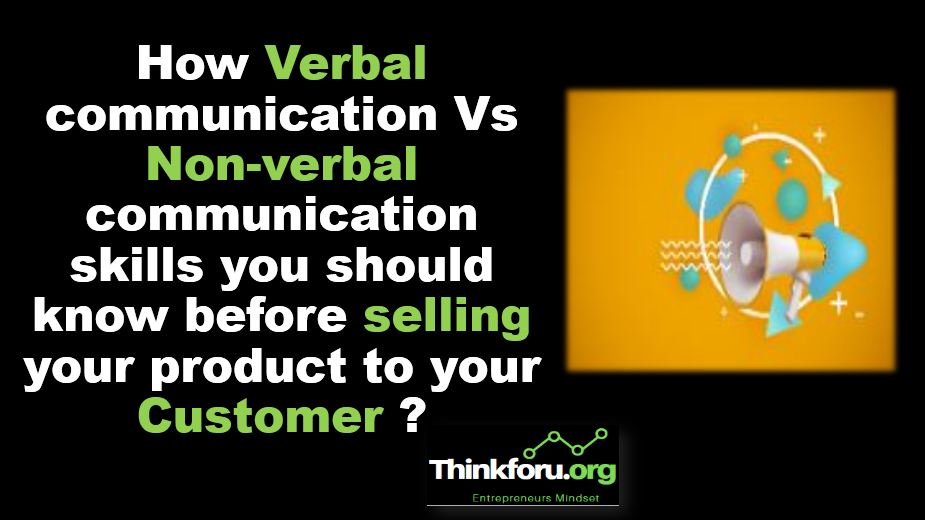How [ Verbal communication Vs Non-verbal communication skills ] you should know before selling your product to your Customer ?
How Verbal communication Vs Non-verbal communication skills you should know before selling your product to your Customer ?
 |
| Cover Image How Verbal communication Vs Non-verbal communication skills you should know before selling your product to your Customer ? |
Verbal communication skills for selling
Your communication skills determine your chances of a sale — from your opening pitch to your closing statements. Developing your questioning, vocal and conversational skills will help you build on a strong first impression by gaining trust and establishing credibility.
Questioning skills
Asking appropriate, purposeful questions can help you identify whether your customer is likely to buy your products, and move them through the selling process.
There are several types of questions that can help you in the sales process:-
1. Closed questions
Closed questions require a simple 'yes' or 'no' answer. For example: 'Are you looking for a television today?'
Closed questions are used to:
a. find out facts
b. limit or guide discussion
c. gather basic information from the customer that you can use to generate an open question.
Open questions
Open questions require a customer to explain or elaborate.
For example: 'What type of product are you looking for?'
Open questions are used to:
a. Gather specific information so you can determine your customer's wants and needs
b. Build relationships with customers so that they are comfortable dealing with you.
Probing questions
Probing questions are about a specific topic to uncover more information.
For example: 'What type of television do you think would fit best on your wall?'
Probing questions are used to:
a. Obtain more specific information in order to fully understand your customer's needs.
b. Uncover and clarify your customer's perceptions and opinions.
Confirming questions
Confirming questions are designed to check that your customer understands what you've said.
For example: 'Which of these features would benefit you most?'
Confirming questions are used to check that you've successfully communicated information to your customer.
Summary confirmation questions
Summary confirmation questions are designed to check that you understand what your customer has told you.
For example: 'Are you saying you'd prefer to order the next model in our range?'
Summary confirmation questions are used to:
a. Check that you understand your customer's needs
b. Check that the benefits you've outlined meet their needs.
Conversational skills
Good salespeople look for a way to make a connection with their customer, and build a conversation based on trust and understanding. Conversation skills include:
a. Asking non-confronting questions to show you genuinely care about your customer's needs
b.Talking knowledgeably about your product or service
c. Displaying interest and warmth
d. Avoiding bias or stereotyping
e. Adjusting to your customer's verbal style
d. Telling the truth
e. Offering observations that show you understand
f.Accepting and acknowledging your customer's opinions
refraining from interrupting or correcting unnecessarily
watching for and responding to signs of discomfort or boredom
being diplomatic making small talk —
when it's called for and to an appropriate degree.
Vocal skills
Good communicators know that what they say is often less important than the way they say it. Use your voice to make an impact by:
a. Adjusting your pitch to suit the conversation
b. Adjusting your volume to ensure clarity, and suit your customer's comfort and hearing needs
c. Speaking in a steady tone of voice to show calm and confidence
d. Slowing the speed of your speech so it is calm and clear varying the inflection in your voice to suit your message - to show enthusiasm, common sense, interest, and gravity
Enunciating your words clearly
Varying the quality and intensity of your voice to hold interest
conveying meaning using the sound of your voice to reinforce your messages.
 |
| Image of Verbal communication Vs Non-verbal communication skills with example |
VS
Non-verbal communication skills for selling
When selling to customers, your non-verbal communication skills – such as active listening and interpreting non-verbal cues – are just as important as what you say.
Developing these skills will help you understand what your customers want, so you can offer them the most suitable products and services.
Listening skills
Listening to your customer to discover their needs helps you suggest appropriate products or services to meet those needs.
Active listening is the process of confirming what you think your customer has said, and meant, by observing their verbal and non-verbal cues. To be a good active listener you should:
focus your full attention on your customer
briefly summarise your understanding of what your customer has said
take notes if necessary
use appropriate non-verbal cues such as nodding your head, inclining your body forward and maintaining eye contact
note your customer's non-verbal cues – are they eager, reluctant, impatient?
use appropriate, well-timed probing questions and summary confirmation questions.
Understanding non-verbal cues
Interpreting your customer's non-verbal signals and behaviours allows you to read their attitude and better understand their needs.
Projecting the right non-verbal cues yourself can help your customer feel at ease. Here are some positive and negative examples of non-verbal cues:
Facial expressions
Bad – wrinkling the nose, furrowing the brow or rolling the eyes
Good – smiling, raised eyebrows, relaxed mouth
Eye contact
Bad – Avoiding your customer or looking outside your sales space.
Good – Looking back to your customer's face and at your products.
Smile
Bad – closed, firm or expressionless mouth
Good – smiling or relaxed mouth
Hands
Bad – hands folded to the chest or near the face
Good – hands moving freely, relaxed, touching the product
Gestures
Bad – closed arms, dismissive hand gestures
Good – open arms, nodding the head
Posture
Bad – slouching, shoulders turned away
Good – standing upright, inclining the body forward
Position
Bad – moving too close, facing away
Good – observing personal space accommodating cultural differences.